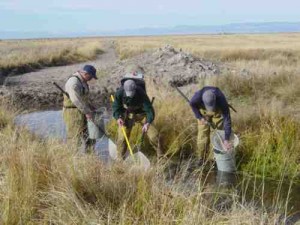Column by John Mattingly
Agriculture – May 2007 – Colorado Central Magazine
Not all subsidies to the ag sector appear in large print.
1. Student grants and loans.When I went to the University of Colorado to get my undergraduate degree at age 51, and then make a run at law school, I was presented with a FAFSA (Free Application For Student Aid). Though I was quite willing to pay the tuition — which I considered a bargain at some $1,600 a semester for my in-state status — I discovered a FAFSA footnote regarding the assets an applicant was required to list in the calculation of eligibility for federal scholarships and loans: “Do not count the value of a family farm that you (or your spouse) or your parents live on and operate.”
Because the FAFSA program is need-based, if no farm assets are counted on the application, a student (or old farmer) from a family farm will meet the highest level of need and thus qualify for the highest level of grants. Family farms are distinguished on the application from “investment farms,” on which no family members actually work. I worked on my farms, and thus qualified for several federal grants, such that going to the University of Colorado was actually a paying proposition.
After learning about the FAFSA exemption, I couldn’t resist playing the “farmer card” with my academic counselor. I argued that, as an old farmer seeking to improve himself by returning to university to get the skills necessary to do something truly worthwhile for society, I didn’t have much time left before final harvest, and needed to skip first-year classes. Though I offered this partly in jest, it was taken with utmost solemnity. I bypassed most freshman classes by taking the final exams, was given permission to take up to 36 credit hours per semester, and ended up getting a BA in three semesters, all tuition, books, and living expenses paid. My son, who attended CU soon after I graduated, enjoyed the same benefits, except those peculiar to being an old farmer.
2. Discount grazing. Ranchers with grazing permits on public lands pay, on average, one-tenth of the going commercial rate for pasture. Considerable history underlies the linkage between ranches and public land grazing permits, such that ranchers often argue the permits are akin to a property right, while the government agencies (Forest Service and Bureau of Land Management) who oversee the permits, refer to the permits strictly as “grazing privileges.”
Permitees have to make necessary improvements to the grazed lands, perform maintenance, and comply with range management directives from the relevant government agency. Regulations regarding the use of grazing permits have tightened considerably in recent years, and in dry years no grazing is allowed. The permitted pastures often require heroic management skills to deal with wild conditions and difficult access. Death losses can be higher than on bottomland pastures. Grazing rates were recently reduced, perhaps due to extended non-use over the recent deep drought.
Because the nature and quality of particular grazing permits varies considerably from place to place, the real, net value of the permits varies so widely among permitees that it is difficult to quantify. But it is a benefit nevertheless.
3. Tax treatments.A taxpayer whose primary source of income is on the Schedule F, doesn’t have to pay estimated quarterly taxes, which is a relief. Ag filers get special accelerated depreciation on purchases of new machinery: up to $110,000 can be claimed in a single year under Section 179. In many cases, however, this is more of a boon to equipment dealers and bankers than growers, because typically a grower will use the accelerated option in an extremely good year, purchasing new equipment that encourages more production in coming years, which usually results in lower prices, which results in losses.
But never mind that, because ag taxpayers get special treatment on NOLs (net operating losses) with several years carry-forward or carry-back. Losses and gains can be spread over periods that, in most cases, give the ag sector a good chance at avoiding the payment of excessive taxes.
Finally, ag taxpayers get a special provision in estate taxes. A farm or ranch can be passed on to children with additional unified tax credits amounting to several million dollars if the recipients stay on the farm for ten years after the primary owner dies.
4. License plates. If a truck is used exclusively ON FARM, or to haul raw agricultural products produced by the farmer, a FARM plate can be purchased at a discount of 30% to 50% below standard plates. The savings is largest for over-the-road farm trucks that haul 25 ton payloads of commodity. Also, if a farmer is hauling his or her own product to market within 150 air miles of the homeplace, the driver is exempt from certain DOT driver’s licensing requirements.
5. Crop Insurance. Federal multi-peril crop insurance can be so good it may have the farmer secretly hoping for hail. The farmer first must verify a proven average per-acre-yield, done over a three year period when everything goes well. That proven yield then becomes the level to which the farmer can now insure all future crops against multi-perils, which is basically everything.
For example, a farmer produces a yield of 150 bushels of wheat per acre in a really good three year stretch. In coming years, the farmer can now insure his crop for a 150 bushel yield, and be paid for any shortfall, regardless of the reason for that shortfall. It’s easy to see how this stimulates abuses. Once a grower has established a high yield, there is an incentive to have a crop loss as early in the season as possible.
6. Irrigation projects. The federal Bureau of Reclamation built many reservoirs and ditch systems for the agricultural community at low interest loans, many of which were never re-paid due to pork barrel politics. Western Congressmen in the ’50s and ’60s scored big points for funding irrigation projects in their states. Wayne Aspinall is Colorado’s figurehead here, having secured funding for tens of millions in statewide water projects. Of course, many of these projects, originally designed for farmers and ranchers, are now serving municipalities.
Summary. These subtle subsidies may be the way our society shows appreciation for farmers as its basic breadwinners. Or perhaps — as noted at the end of last month’s essay — it’s a way of absolving the vague, low-level guilt society feels, knowing food is cheaper than the interest most households pay on their home and car.
It wasn’t just the smell of thawing earth in the spring and joy of green fields in summer that kept me in the fields all those years. Farming is a job with decent, though subtle, benefits.
John Mattingly most recently farmed near Moffat.



